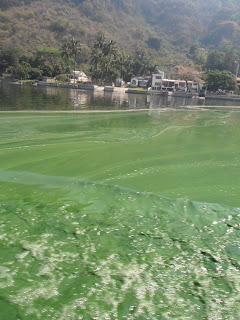Expedicion Atitlan 2012:
Capacity Building Within Guatemalan Institutions for Understanding
Changes and Monitoring Health
Lake Atitlan
is located in the highlands of Guatemala and has been described as one of the
most beautiful lakes in the world.
In recent
years the lake’s ecology has undergone dramatic alteration due to increasing
pollution. In December 2008, the lake underwent a dramatic regime shift when a
large cyanobacterial algal bloom occurred.
The news
about the bloom spread quickly with local residents concerned about the
clarity, ecology, and “health” of the lake. There has been very little
limnological research at the lake with a shortage of information to understand
the mechanisms contributing to the lake’s alteration. In April 2010, a team of
international researchers arrived at Lake Atitlan to work with their Guatemalan
counterparts to initiate a collaboration to understand lake processes and
conserve the lake and assist the residents of Guatemala in understanding why
the lake was changing.
With funding from USAID, the Expedicion
Atitlan 2012 strives to build Guatemala's capacity to monitor environmental conditions at Lake Atitlan, to promote scientifically sound policy decision making among local and national leaders concerning the lake, and to educate members of lake communities on the importance of environmental stewardship on their health and livelihoods.
The main
objectives of this program will address detrimental environmental and man-made
impacts on Lake Atitlán through:
1. Promotion
and strengthening of existing monitoring/ research programs and development of
a long-term, scientifically based monitoring framework across the watershed
(lake, river, land, atmosphere).
2. Compilation
and quality control of existing lake and river data and place this information
into a database available to all parties working to conserve Lake Atitlán.
3. Creation
of infrastructure in Guatemalan institutions through the purchase of modern
laboratory and field instrumentation that can be deployed and maintained by
Guatemalan institutions in the future.
4. Training
of young Guatemalan scientists in the proper use of this instrumentation, data
analysis, and sharing information with policy makers through public-friendly
reports and presentations to implement programs that will restore Lake Atitlán.
5. Development
and implementation of a communication and sustainability strategy for this
initiative that can jointly contribute to the economic development of the Lake
Atitlán Watershed.
We are all
excited to work together and get started on this exciting project!!!














